Simulation Assessment of Inlet Parameters and Membrane-Surface-Structure Effects on CO2 Absorption Flux in Membrane Contactors
Abstract
:1. Introduction
2. Computational Fluid Dynamics (CFD) Simulation in Reactive Mode
2.1. Simulation Assumptions
- -
- Feed gas on the shell side is pure CO2 to simplify the mass transfer resistance on the gas side. Otherwise, gas phase resistance becomes important, and the whole membrane with tortuosity and pore size should be considered, which is practically impossible to run, even with a supercomputer.
- -
- Laminar and a steady-state hydrodynamically fully developed MEA solution is considered for feed flow. Although this assumption might not be ideal for the entrance length, it is the most suitable assumption. Otherwise, it would take too much processing time and power without much change in results.
- -
- Isothermal feed flow all over the module.
- -
- A very smooth wall (no-slip condition at the wall).
- -
- -
- Henry’s law was applied to calculate the CO2 concentration at the interface of the gas–liquid contact at the mouth of the pores (i.e., thermodynamic equilibrium state).
- -
- The non-wetted mode was assumed, indicating that the pores are filled with CO2 with no absorbent entry into the pores.
- -
- The reaction between CO2 and the MEA is very fast (instantaneous), as the reaction parameters satisfied the instantaneous reaction regime conditions, as can be seen in [22].
- -
- Axis symmetry condition is assumed at the hollow fiber axis.
2.2. Governing Equations
- -
- Zero CO2 concentration is assumed at the hollow fiber inlet with the MEA concentration equal to the feed concentration.
- -
- CO2 concentration is calculated using Equation (3) with no MEA flux at the pore mouths.
- -
- Outflow condition is also considered at the fiber outlet.
- -
- The rest of the membrane surfaces are considered walls with no-slip conditions.
2.3. Simulation Time Reduction
2.4. Mesh Dependency Test
3. Results and Discussion
3.1. Simulation Validation
3.2. Effect of Average Absorbent Velocity
3.3. The Effect of Changing the Porosity and Pore Size
4. Conclusions and Future Work
Author Contributions
Funding
Institutional Review Board Statement
Informed Consent Statement
Data Availability Statement
Acknowledgments
Conflicts of Interest
References
- Gabelman, A.; Hwang, S.T. Hollow Fiber Membrane Contactors. J. Membr. Sci. 1999, 159, 61–106. [Google Scholar] [CrossRef]
- Sreenivasulu, B.; Gayatri, D.V.; Sreedhar, I.; Raghavan, K.V. A Journey into the Process and Engineering Aspects of Carbon Capture Technologies. Renew. Sustain. Energy Rev. 2015, 41, 1324–1350. [Google Scholar] [CrossRef]
- Li, J.L.; Chen, B.H. Review of CO2absorption Using Chemical Solvents in Hollow Fiber Membrane Contactors. Sep. Purif. Technol. 2005, 41, 109–122. [Google Scholar] [CrossRef]
- Mansourizadeh, A.; Ismail, A.F. Hollow Fiber Gas-Liquid Membrane Contactors for Acid Gas Capture: A Review. J. Hazard. Mater. 2009, 171, 38–53. [Google Scholar] [CrossRef] [PubMed]
- Mosadegh-Sedghi, S.; Rodrigue, D.; Brisson, J.; Iliuta, M.C. Wetting Phenomenon in Membrane Contactors—Causes and Prevention. J. Membr. Sci. 2014, 452, 332–353. [Google Scholar] [CrossRef]
- Yan, Y.; Zhang, Z.; Zhang, L.; Chen, Y.; Tang, Q. Dynamic Modeling of Biogas Upgrading in Hollow Fiber Membrane Contactors. Energy Fuels 2014, 28, 5745–5755. [Google Scholar] [CrossRef]
- Wang, R.; Li, D.F.; Liang, D.T. Modeling of CO2 Capture by Three Typical Amine Solutions in Hollow Fiber Membrane Contactors. Chem. Eng. Process. Process Intensif. 2004, 43, 849–856. [Google Scholar] [CrossRef]
- Nakhjiri, A.T.; Heydarinasab, A.; Bakhtiari, O.; Mohammadi, T. The Effect of Membrane Pores Wettability on CO2 Removal from CO2/CH4 Gaseous Mixture Using NaOH, MEA and TEA Liquid Absorbents in Hollow Fiber Membrane Contactor. Chin. J. Chem. Eng. 2018, 26, 1845–1861. [Google Scholar] [CrossRef]
- Rosli, A.; Shoparwe, N.F.; Ahmad, A.L.; Low, S.C.; Lim, J.K. Dynamic Modelling and Experimental Validation of CO2 Removal Using Hydrophobic Membrane Contactor with Different Types of Absorbent. Sep. Purif. Technol. 2019, 219, 230–240. [Google Scholar] [CrossRef]
- Rongwong, W.; Jiraratananon, R.; Atchariyawut, S. Experimental Study on Membrane Wetting in Gas-Liquid Membrane Contacting Process for CO2 Absorption by Single and Mixed Absorbents. Sep. Purif. Technol. 2009, 69, 118–125. [Google Scholar] [CrossRef]
- Shoukat, U.; Pinto, D.D.D.; Knuutila, H.K. Study of Various Aqueous and Non-Aqueous Amine Blends for Hydrogen Sulfide Removal from Natural Gas. Processes 2019, 7, 160. [Google Scholar] [CrossRef] [Green Version]
- Shirazian, S.; Nakhjiri, A.T.; Heydarinasab, A.; Ghadiri, M. Theoretical Investigations on the Effect of Absorbent Type on Carbon Dioxide Capture in Hollow-Fiber Membrane Contactors. PLoS ONE 2020, 15, e0236367. [Google Scholar] [CrossRef] [PubMed]
- Aaron, D.; Tsouris, C. Separation of CO2 from Flue Gas: A Review. Sep. Sci. Technol. 2005, 40, 321–348. [Google Scholar] [CrossRef]
- Ji, G.; Zhao, M. Membrane Separation Technology in Carbon Capture. In Recent Advances in Carbon Capture and Storage; Yun, Y., Ed.; InTech: Rijeka, Croatia, 2017; Chapter 3; ISBN 978-953-51-3006-2. [Google Scholar]
- Seader, J.D.; Henley, E.J.; Roper, D.K. Separation Process Principles. Choice Rev. Online 1999, 36, 36–5112. [Google Scholar] [CrossRef]
- He, X.; Hägg, M.B. Membranes for Environmentally Friendly Energy Processes. Membranes 2012, 2, 706–726. [Google Scholar] [CrossRef] [PubMed] [Green Version]
- Kreulen, H.; Smolders, C.A.; Versteeg, G.F.; van Swaaij, W.P.M. Microporous Hollow Fibre Membrane Modules as Gas-Liquid Contactors. Part 1. Physical Mass Transfer Processes. A Specific Application: Mass Transfer in Highly Viscous Liquids. J. Membr. Sci. 1993, 78, 197–216. [Google Scholar] [CrossRef] [Green Version]
- Kreulen, H.; Smolders, C.A.; Versteeg, G.F.; van Swaaij, W.P.M. Microporous Hollow Fibre Membrane Modules as Gas-Liquid Contactors Part 2. Mass Transfer with Chemical Reaction. J. Membr. Sci. 1993, 78, 217–238. [Google Scholar] [CrossRef] [Green Version]
- Yuliwati, E.; Ismail, A.F. Effect of Additives Concentration on the Surface Properties and Performance of PVDF Ultrafiltration Membranes for Refinery Produced Wastewater Treatment. Desalination 2011, 273, 226–234. [Google Scholar] [CrossRef]
- Yuliwati, E.; Ismail, A.F.; Matsuura, T.; Kassim, M.A.; Abdullah, M.S. Effect of Modified Pvdf Hollow Fiber Submerged Ultrafiltration Membrane for Refinery Wastewater Treatment. Desalination 2011, 283, 214–220. [Google Scholar] [CrossRef]
- Rajabzadeh, S.; Yoshimoto, S.; Teramoto, M.; Al-Marzouqi, M.; Ohmukai, Y.; Maruyama, T.; Matsuyama, H. Effect of Membrane Structure on Gas Absorption Performance and Long-Term Stability of Membrane Contactors. Sep. Purif. Technol. 2013, 108, 65–73. [Google Scholar] [CrossRef]
- Rajabzadeh, S.; Yoshimoto, S.; Teramoto, M.; Al-Marzouqi, M.; Matsuyama, H. CO2 absorption by Using PVDF Hollow Fiber Membrane Contactors with Various Membrane Structures. Sep. Purif. Technol. 2009, 69, 210–220. [Google Scholar] [CrossRef]
- Albarracin Zaidiza, D.; Wilson, S.G.; Belaissaoui, B.; Rode, S.; Castel, C.; Roizard, D.; Favre, E. Rigorous Modelling of Adiabatic Multicomponent CO2 Post-Combustion Capture Using Hollow Fibre Membrane Contactors. Chem. Eng. Sci. 2016, 145, 45–58. [Google Scholar] [CrossRef]
- Kumar, P.S.; Hogendoorn, J.A.; Feron, P.H.M.; Versteeg, G.F. Approximate Solution to Predict the Enhancement Factor for the Reactive Absorption of a Gas in a Liquid Flowing through a Microporous Membrane Hollow Fiber. J. Membr. Sci. 2003, 213, 231–245. [Google Scholar] [CrossRef]
- Albarracin Zaidiza, D.; Billaud, J.; Belaissaoui, B.; Rode, S.; Roizard, D.; Favre, E. Modeling of CO2 Post-Combustion Capture Using Membrane Contactors, Comparison between One- and Two-Dimensional Approaches. J. Membr. Sci. 2014, 455, 64–74. [Google Scholar] [CrossRef]
- Kumar, P.S.; Hogendoorn, J.A.; Feron, P.H.M.; Versteeg, G.F. New Absorption Liquids for the Removal of CO2 from Dilute Gas Streams Using Membrane Contactors. Chem. Eng. Sci. 2002, 57, 1639–1651. [Google Scholar] [CrossRef] [Green Version]
- Rezakazemi, M.; Niazi, Z.; Mirfendereski, M.; Shirazian, S.; Mohammadi, T.; Pak, A. CFD Simulation of Natural Gas Sweetening in a Gas–Liquid Hollow-Fiber Membrane Contactor. Chem. Eng. J. 2011, 168, 1217–1226. [Google Scholar] [CrossRef]
- Yuan, C.; Li, L.; Li, Y.; Pan, Z.; Zhang, N.; Borhani, T.N.; Zhang, Z. Modeling of CO2 Absorption into 4-Diethylamino-2-Butanol Solution in a Membrane Contactor under Wetting or Non-Wetting Conditions. Carbon Capture Sci. Technol. 2022, 100069. [Google Scholar] [CrossRef]
- Ismail, M.S.; Mohamed, A.M.; Poggio, D.; Walker, M.; Pourkashanian, M. Modelling Mass Transport within the Membrane of Direct Contact Membrane Distillation Modules Used for Desalination and Wastewater Treatment: Scrutinising Assumptions. J. Water Process Eng. 2022, 45, 102460. [Google Scholar] [CrossRef]
- Zhang, X.; Koirala, R.; Date, A.; Jegatheesan, V. Modelling and Simulation of Flux Prediction and Salinity Variation in Direct Contact Membrane Distillation for Seawater Desalination and Brine Treatment. Desalination 2022, 540, 116021. [Google Scholar] [CrossRef]
- Bird, R.B.; Stewart, W.E.; Lightfoot, E.N. Transport Phenomena, Revised Se; John Wiley & Sons: New York, NY, USA, 2006. [Google Scholar]
- Hikita, H.; Asai, S.; Ishikawa, H.; Honda, M. The Kinetics of Reactions of Carbon Dioxide with Monoethanolamine, Diethanolamine and Triethanolamine by a Rapid Mixing Method. Chem. Eng. J. 1977, 13, 7–12. [Google Scholar] [CrossRef]
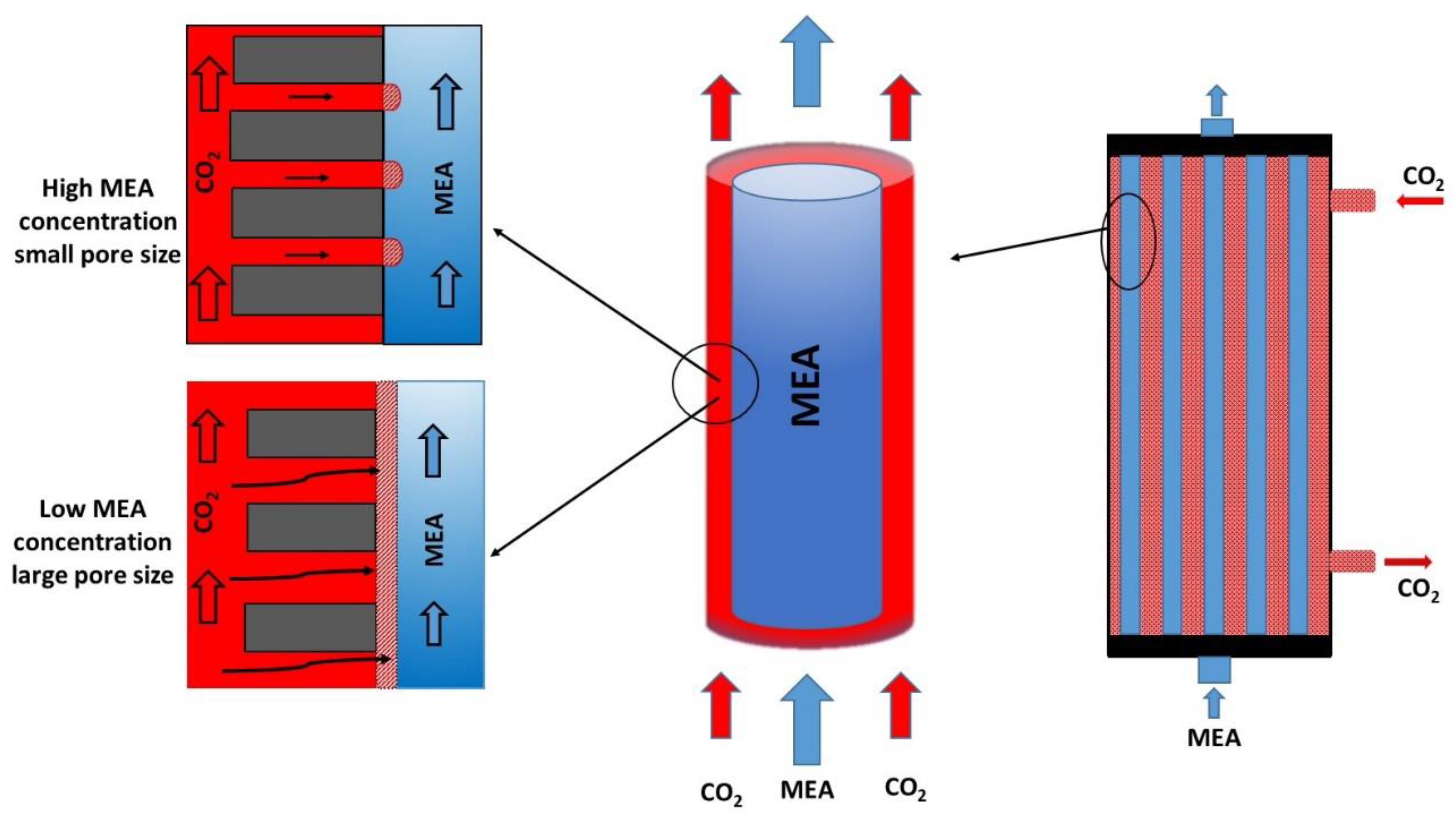


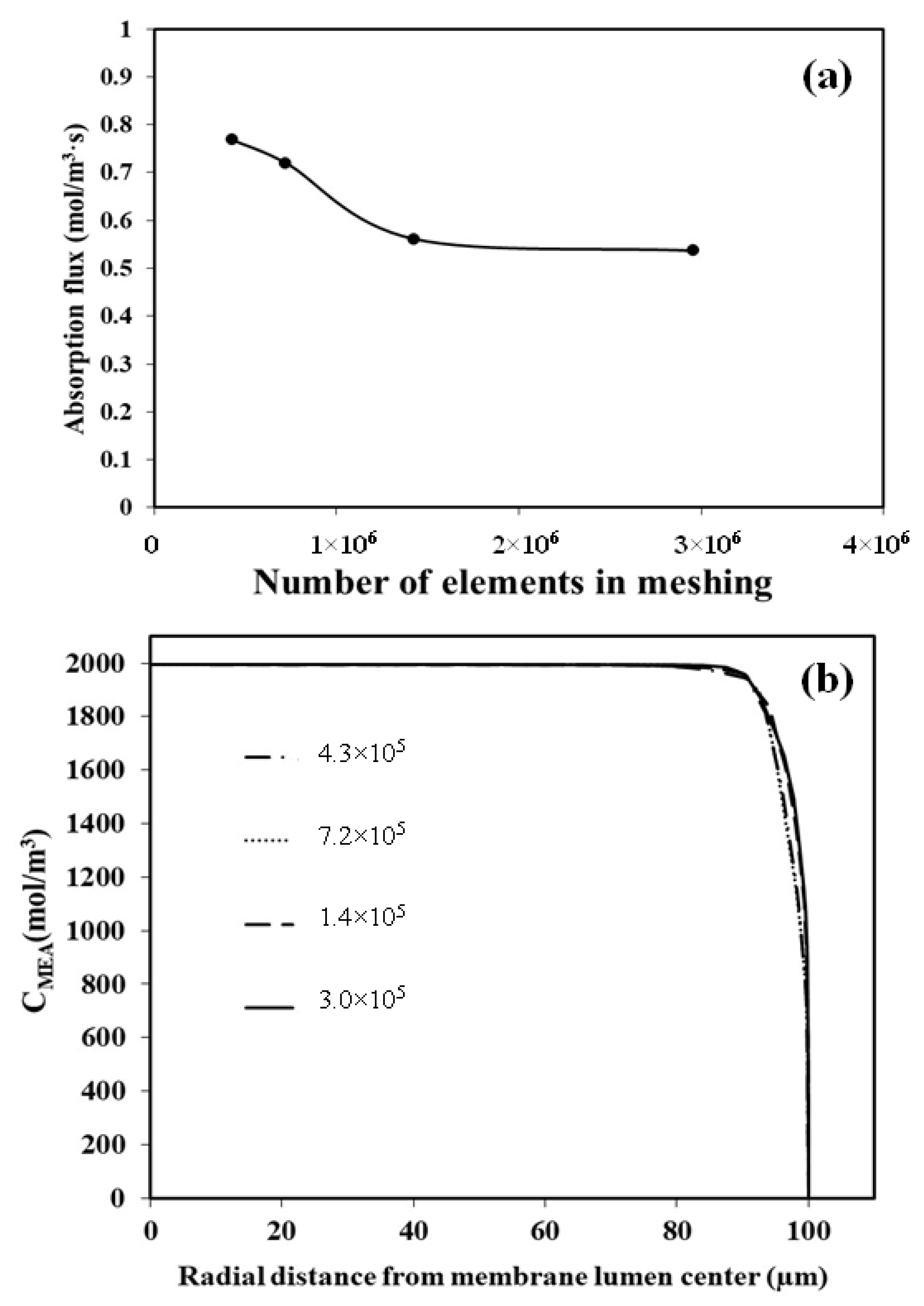




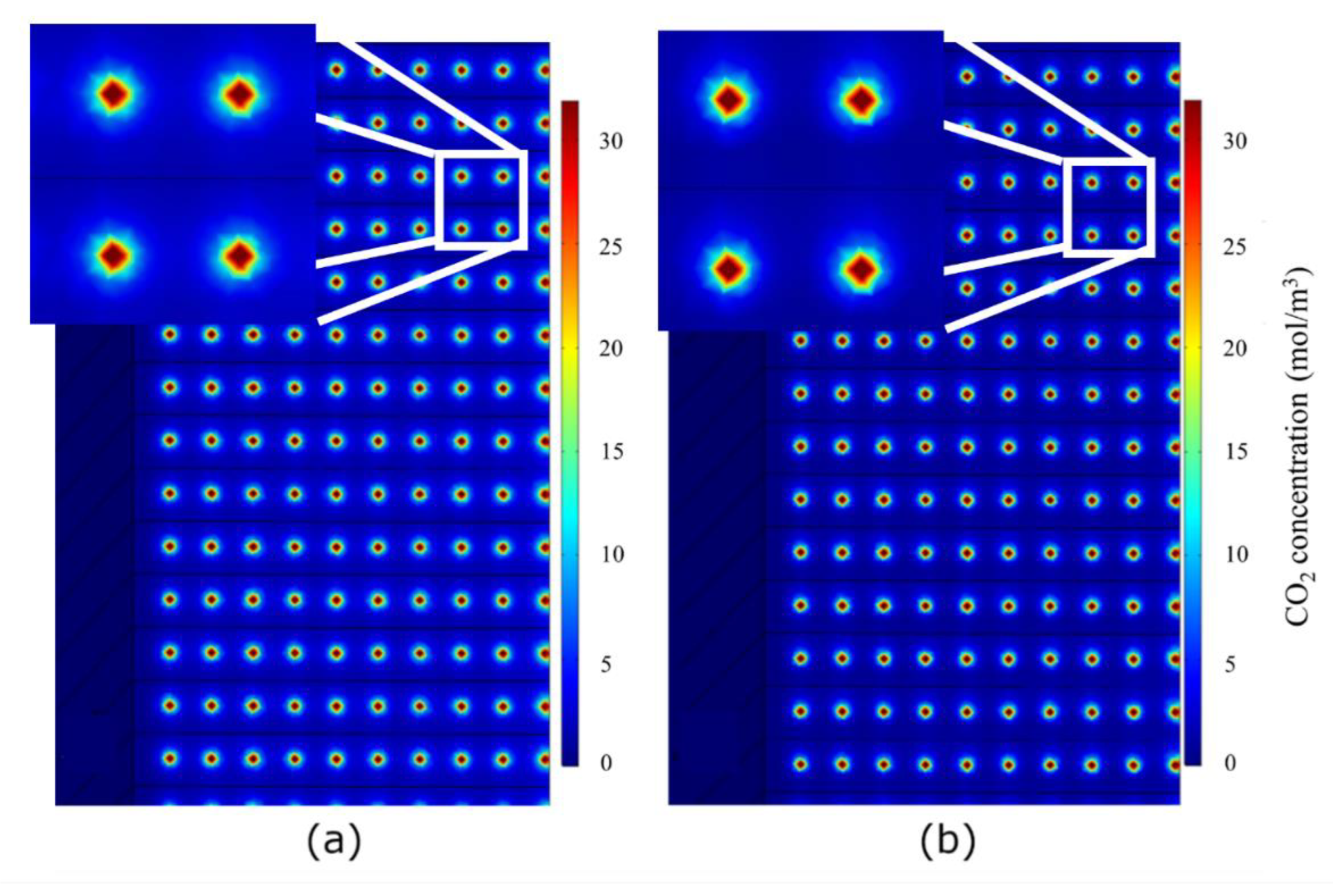
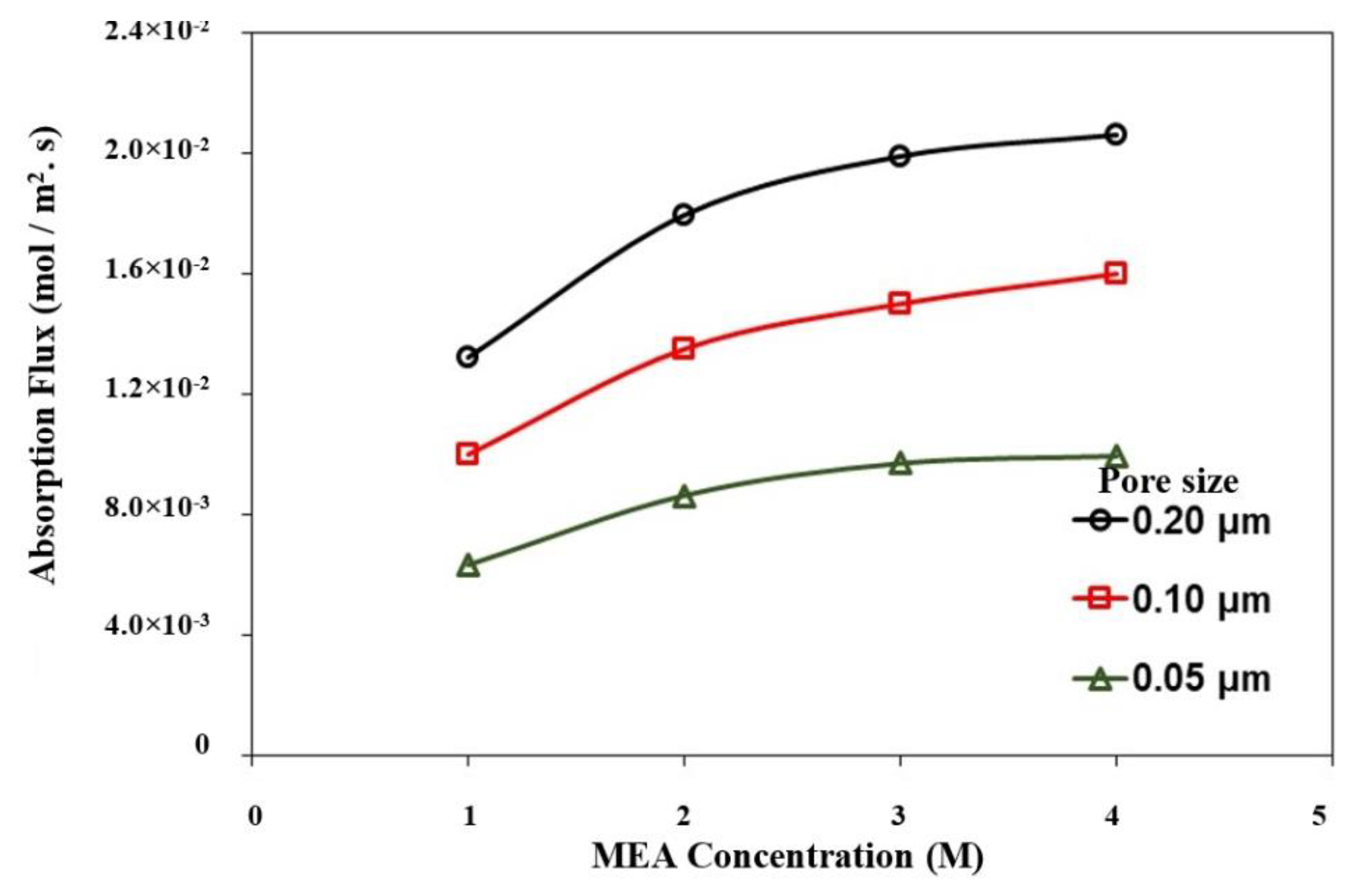
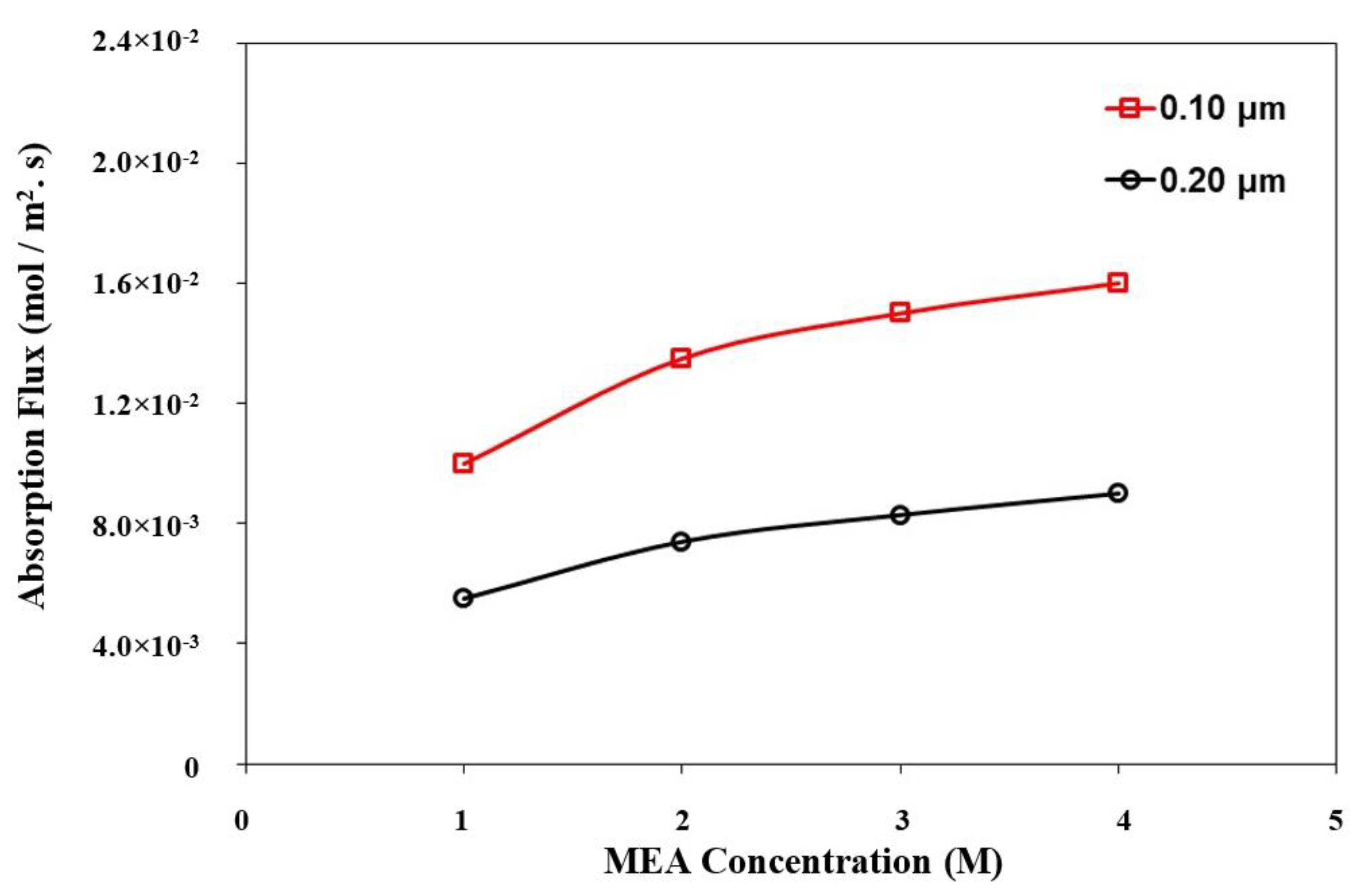

| MEA Concentration (M) | 1 | 2 | 3 | 4 |
|---|---|---|---|---|
| (m2/s) | ||||
| (m2/s) | ||||
| (mol/m3·kPa) | ||||
| (m3/mol·s) | ||||
| Cutting Angle (°) | 90 | 45 | 27 | 9 | 2.5 | |
|---|---|---|---|---|---|---|
| Fiber Length (µm) | Absorption Flux (mol/m2·s) | |||||
| 100 | 0.932 | 0.931 | 0.931 | 0.930 | 0.930 | |
| 300 | 0.392 | 0.392 | 0.390 | 0.390 | 0.389 | |
| 600 | - | 0.260 | 0.259 | 0.258 | 0.258 | |
| 900 | - | - | 0.24 | 0.24 | 0.24 | |
| 1800 | - | - | - | 0.199 | 0.198 | |
| 3600 | - | - | - | 0.174 | 0.174 | |
| 7200 | - | - | - | - | 0.161 | |
| MEA Concentration (mol/L) | Absorbent Velocity (m/s) | Pore Size (µm) | Surface Porosity |
|---|---|---|---|
| 2 | 0.25 | 0.1 | 1% |
| MEA Concentration (mol/L) | 1 | 2 | 3 | 4 |
|---|---|---|---|---|
| A | 0.2634 | 0.5194 | 0.7055 | 0.8807 |
| B | −0.04652 | −0.09283 | −0.1269 | −0.1592 |
Publisher’s Note: MDPI stays neutral with regard to jurisdictional claims in published maps and institutional affiliations. |
© 2022 by the authors. Licensee MDPI, Basel, Switzerland. This article is an open access article distributed under the terms and conditions of the Creative Commons Attribution (CC BY) license (https://creativecommons.org/licenses/by/4.0/).
Share and Cite
Garehbagh, A.M.; Rajabzadeh, S.; Shouman, M.A.; Elmarghany, M.R.; Salem, M.S.; Arahman, N.; Mohammadi, T.; Matsuyama, H. Simulation Assessment of Inlet Parameters and Membrane-Surface-Structure Effects on CO2 Absorption Flux in Membrane Contactors. Sustainability 2022, 14, 14527. https://doi.org/10.3390/su142114527
Garehbagh AM, Rajabzadeh S, Shouman MA, Elmarghany MR, Salem MS, Arahman N, Mohammadi T, Matsuyama H. Simulation Assessment of Inlet Parameters and Membrane-Surface-Structure Effects on CO2 Absorption Flux in Membrane Contactors. Sustainability. 2022; 14(21):14527. https://doi.org/10.3390/su142114527
Chicago/Turabian StyleGarehbagh, Amin Mojarad, Saeid Rajabzadeh, Mahmoud A. Shouman, Mohamed R. Elmarghany, Mohamed S. Salem, Nasrul Arahman, Toraj Mohammadi, and Hideto Matsuyama. 2022. "Simulation Assessment of Inlet Parameters and Membrane-Surface-Structure Effects on CO2 Absorption Flux in Membrane Contactors" Sustainability 14, no. 21: 14527. https://doi.org/10.3390/su142114527








